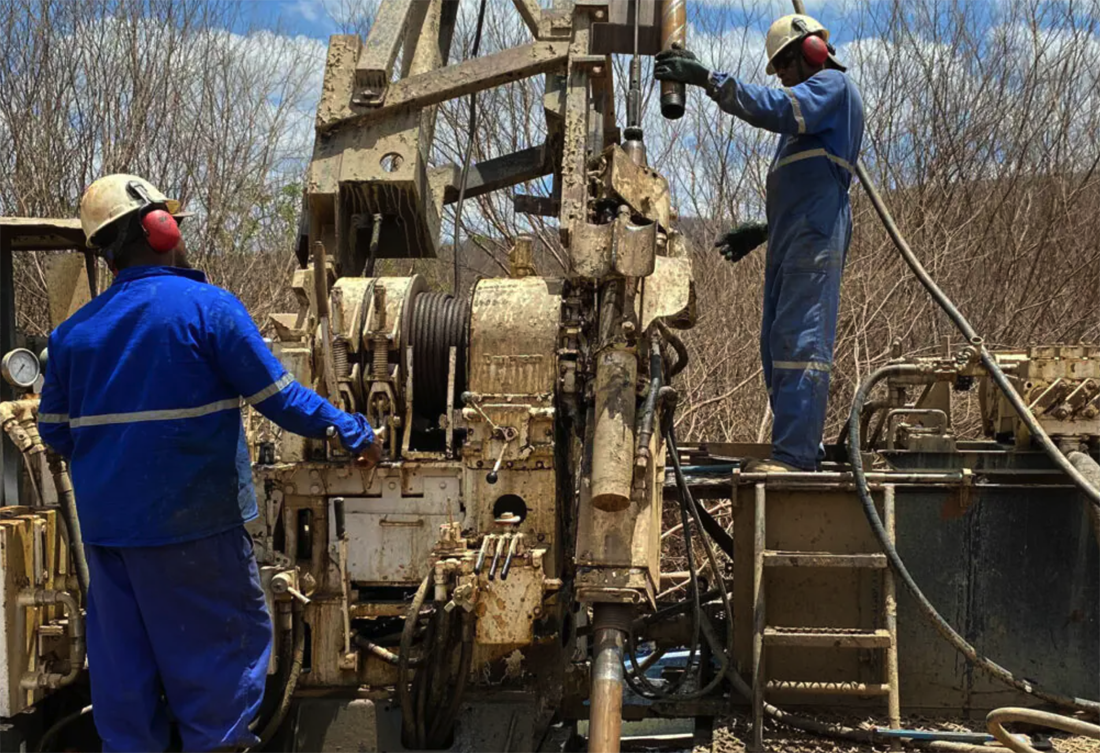TICKERS: BHP; BHPLF, FMC, GXY; GALXF, , RIO; RTPPF, RCK; RCKTF; RJIA, ROC, SQM; SQM-B; SQM-A, ROC, WLCDF
Chris Berry: Big Multiples Expected for Patient Lithium Investors
Interview
Source: George Mack of The Energy Report (9/1/11)
 Although lithium equities have not elevated moods much recently, House Mountain Partners founder Chris Berry makes his case that over the longer term the element will be in such strong demand for the electric vehicle (EV) revolution that investors will no longer be able to ignore explorers and emerging producers. The crucial growth driver is the nascent lithium-ion battery industry that will be vital to management and allocation of energy sources ranging from nuclear and coal to wind and solar. In this exclusive Energy Report interview, Chris has identified several publicly traded lithium juniors priced low enough to reward patient investors with big multiples on investment.
Although lithium equities have not elevated moods much recently, House Mountain Partners founder Chris Berry makes his case that over the longer term the element will be in such strong demand for the electric vehicle (EV) revolution that investors will no longer be able to ignore explorers and emerging producers. The crucial growth driver is the nascent lithium-ion battery industry that will be vital to management and allocation of energy sources ranging from nuclear and coal to wind and solar. In this exclusive Energy Report interview, Chris has identified several publicly traded lithium juniors priced low enough to reward patient investors with big multiples on investment.
Chris Berry: I think it tells us both. If you look at recent gross domestic product (GDP) data in the United States or, most recently in Germany, many Western economies are in stall speed with second quarter GDP numbers barely coming in above zero. So, the world economy is at a little bit of a crossroads—the West is slowing down and relying on the East as the sole engine of economic growth. There is a risk of a double-dip recession here in the United States, but I think it remains to be seen if that will happen. Regarding whether lithium equities are a "screaming buy," I think there are some lithium stocks that are undervalued at their current levels, but it's not safe to assume that all lithium stocks are a buy right now.
There are two reasons you've seen lithium equities get pushed down in the last couple of months. The first has to do directly with uncertainty in Western economies. Second is the fact that there are likely too many junior exploration companies in the lithium space based on current and near-term supply and demand. So based on these two factors, everyone is just getting pounded. It's a flight to quality, and it's a reaction of fear in terms of where to put your money, which is why you've seen gold hit historic highs. Lithium, itself, is an industrial metal, whether or not it's used for polishing glass, as a grease, or its most popular current-day use—in batteries. The long-term potential of lithium rests with growth and innovation in the automotive industry. Electric vehicles are a key growth driver for lithium demand in the future. So electrification in the automotive industry, energy storage and consumer electronics demand are all themes to focus on when developing an opinion on long-term lithium demand. There is a great deal of debate in scientific circles regarding what the optimal battery chemistry is or will be. Lithium will play a central role here, but there are other choices, as well, clouding the end game.
TER: Will some look back at this as a missed opportunity in lithium equities?
CB: I think so as long as you are selective. One of the main themes that we look at in our research at House Mountain is how GDP growth is directly related to access to cheap and reliable energy. How that energy is generated is a question with a number of different answers. If you think about the potential that lithium has in terms of energy storage and generation, it will no doubt play a role in the world's future energy mix. Hydrocarbons will always be with us thanks to their availability and energy density, but lithium will, in my opinion, play a central role in transportation. This isn't something that is going to all shake itself out next week or next year. We are looking at a process that is slowly evolving.
TER: At the end of June, Rockwood Holdings, Inc. (NYSE:ROC), a $4 billion market-cap company announced a 20% lithium price increase and the stock really responded quite well until things began to turn down. What is driving that kind of pricing power?
CB: You are absolutely right about Rockwood. I believe a week or two after the Rockwood announcement FMC Lithium, a division of FMC Lithium Corporation (NYSE:FMC) raised prices as well. The prices of select lithium end products were increased by 20–25%. What I read into this was the fact that there is a substantial amount of raw materials inflation globally and these companies are passing higher costs on to their customers. It remains to be seen whether these higher prices stick.
TER: Right now, given the current economic environment, what is the bull case for lithium?
CB: I'm not sure the bull case is particularly compelling, again, because you're looking at a predominantly industrial mineral facing a slowing global economy; granted some economies are expanding faster than others. I think the lithium industry draws an interesting parallel with the rare earth industry. You are at the beginning stages of a huge shake out in the rare earth space where many of the junior explorers there won't achieve production as the small size of the market cannot support the 200-plus companies involved in rare earth exploration. With lithium, you've got four primary global producers and a couple near-term producers in a market that today has too many participants given the current global lithium demand picture.
But I do think over the coming years as this emerging growth phenomenon in countries like China, Brazil and India continues and other economies recover, the case for lithium is strong. Lithium can play a huge role, whether or not it's in electricity generation, electricity storage, or the transportation sector. I don't want to underestimate how critical a viable transportation sector is to any economy. If you think about supply chains and what they mean to a given economy in terms of the movement of raw materials, the transportation sector is absolutely critical to maintaining or sustaining any increased quality of life.
TER: I know you travel to Latin America at times. Exports from Chile and Argentina are up over last year, and the lithium industry looks very positive down there. What's going on in South America? Is this a resource issue, a policy issue or both?
CB: I think it's a mixture of both. When you talk about Chile and Argentina, they are two of the top lithium producers and exporters in the world. Most, if not all, of the producers are brines and they are solidly economic. You have healthy demand for lithium and lithium carbonate coming from Asia so that's, in my opinion at least, why you are seeing these export numbers increase from Chile and Argentina. Both of these countries have mining as a central driver of their economic growth. Various provinces in both countries have been mining metals—lithium, gold, copper, you name it—for hundreds of years. They also understand how important mining is to local economies. I know, for example, in some provinces in Argentina, the mining industry accounts for up to 70% of the local economy. So it's an overwhelming engine of growth. That's not lost on local and national politicians in these countries. These countries are stable geopolitical jurisdictions with a set rule of law and very clear royalty schemes. That is what attracts foreign direct investment and creates jobs.
TER: I don't know if you go to Australia, but it's friendly to mining as well, isn't it?
CB: I was actually in Australia visiting Talison Lithium Ltd.'s (TSX:TLH) Greenbushes project in April. Australia is an extremely mining friendly country. What is interesting there, however, is that the last few heads of state have tried to push ahead with a carbon tax. It's no surprise that the proposed higher taxes have been viewed unfavorably by large producers with operations there—Rio Tinto (NYSE:RIO; ASX:RIO) and BHP Billiton Ltd. (NYSE:BHP; OTCPK:BHPLF) for example. It remains to be seen what will come of this legislation, but it is really one of the only potential stumbling blocks I see in an otherwise solid mining jurisdiction.
TER: Speaking of Talison, its chart is an inverse or mirror image pattern to Sociedad Química y Minera de Chile S.A. (NYSE:SQM; SSX:SQM-B, SQM-A). I was comparing them because they are the two largest producers of lithium. Over the past six months, Sociedad Química is up 10%, and Talison is down 41%. Talison is the world's largest producer, and it's set to double production by 2013 with expansion of its Greenbushes project you just spoke about. Why has it underperformed so badly?
CB: I have followed Talison for a long time and visiting the site provided a lot of new perspective. This is a company that has been producing high-grade lithium for 25 years. It has a very strong technical team that knows exactly what it is doing. It is mining an asset that is actually the highest grade hard rock lithium in the world. I don't know if that is necessarily lost on the market, but in the mining industry one of the themes in terms of evaluating a project is that grade is king. If that's the case, then Talison is a runaway winner. You have an asset with a substantial mine life with an incredibly high grade in a safe geopolitical jurisdiction that supplies China with upwards of 75% of that country's lithium needs. Think about the growth taking place in China in cleantech research and the battery manufacturing business. The overwhelming majority of the lithium used here comes from Talison.
Talison is the only pure-play lithium producer in the world. So comparing it to a company like FMC or Sociedad Química or Rockwood is not exactly fair because those are chemical companies that produce fertilizers and other chemicals aside from lithium.
TER: At the risk of comparing apples and oranges once again, Sociedad Química is a brine producer of lithium. Talison is a hard rock producer. Which method do you prefer?
CB: On a cost per-ton basis and on a head-to-head evaluation, the brines are cheaper. But it can take 18 months to extract and evaporate the brine and produce lithium carbonate, whereas with hard rock you can do it much faster. How Talison competes with brine producers is interesting. In many cases, it can out-compete brine producers because it is producing such high-grade product. Even though mining may be more expensive for Talison compared to a brine producer, its higher grade allows it to capture a higher margin for the end product that it sells.
TER: Chris, what other companies are you talking to investors about?
CB: One, in particular, that we are focusing on right now is Lithium One Inc. (TSX.V:LI). This is a company that has two assets—a brine asset in Argentina, which is its centerpiece project, and a hard rock pegmatite property in the James Bay region of Quebec. The company is planning on producing lithium carbonate and potash from the Argentinean property named Sal de Vida. In the lithium space, I like to see this because if you can produce a byproduct profitably, that is going to lower your overall cost of production. Additionally, you have very strong management in Paul Matysek and Patrick Highsmith.
TER: Do you give Lithium One an advantage because it produces from both hard rock and brine?
CB: The company isn't yet producing from either, but plans on production from the brines first. I suppose there is an advantage in having a diversity of supply, but the real advantage will be that it will be predominantly producing lithium from the brine along with potash and lowering overall cost of production. So that is the advantage. This asset borders a property from which FMC is now producing and has substantial grades of both lithium and potash.
Near-term catalysts for this company are a preliminary economic assessment in Q311 and a prefeasibility study in the middle of 2012. We are looking for positive catalysts over the next 6–12 months here.
One of the other things we really like about Lithium One is the fact that it has done strategic joint ventures for each of its assets. For the Sal de Vida property, it has partnered with a Korean consortium of three different companies—LG International Corp., Korea Resource Corporation (KORES) and GS Caltex Corp. The consortium will fund the project to feasibility in exchange for up to a 30% ownership of the property. The key benefit for the consortium is to lock up a secure supply of raw material. For Lithium One, the company is carried to feasibility. It is important to consider how a company is going to ultimately start generating cash. Is it going to continue to dilute through share issuance to get there? In my opinion, Lithium One has really executed a masterstroke in negotiating a partnership with this Korean consortium.
On its James Bay asset in Quebec, Lithium One has done the same thing with Galaxy Resources Ltd. (ASX:GXY), which is a company that just started producing lithium in Australia on its own. Galaxy can earn up to 70% of the James Bay property by completing a definitive feasibility study by the end of 2012. So Galaxy can ensure security of supply and Lithium One is carried to definitive feasibility on the project.
Another interesting company is Western Lithium USA Corp. (TSX:WLC; OTCQX:WLCDF). It's a little bit of a hybrid as it's not a traditional brine or hard rock play. This is a very large clay asset in Nevada called Kings Valley. Western Lithium recently updated its NI 43-101 resource estimate, which I think was received positively as the tonnage and grade of the deposit increased, which helps the already good economics of the project. When you talk about lithium, one of the keys is security of supply. When the electric vehicle revolution really takes hold, the idea of having a ready domestic supply of the key asset lithium carbonate is of paramount importance. I'm currently reading a book titled "Bottled Lightning: Superbatteries, Electric Cars, and the New Lithium Economy" by Seth Fletcher. In the book, the "story" of Western Lithium is told and WLC CEO Jay Chemelauskas is featured prominently. The book is an interesting read on the history of lithium's role in electrification and more importantly, it's future.
TER: What about earlier stage plays?
CB: We have talked about Rock Tech Lithium Inc. (TSX.V:RCK; OTCPK:RCKTF; Fkft:RJIA) before. This is a very early-stage play. It's not quite as far along as Lithium One or certainly not as far as Talison. Rock Tech is a hard rock explorer and it has several assets in Ontario and Quebec. The primary property is the Georgia Lake lithium deposit about 200 km. north of Thunder Bay, Ontario. It has a historic resource, and it will be updating and releasing information on that before the end of the year. So we will get an idea of the tonnage and grade of its Georgia Lake asset. It also has an asset in Quebec that borders Lithium One's hard rock deposit. You can take a look at the tonnage and grade specifics for Lithium One at James Bay and infer what Rock Tech might have if the geology underlying the deposits is consistent and continuous.
TER: Will that upcoming resource estimate be an NI 43-101? What has been the historic estimate?
CB: It will be a qualified NI 43-101 resource estimate. The historic estimate at its Georgia Lake prospect is 9.8 million tons of lithium oxide at a grade of 1.18%. Rock Tech is conducting bulk sampling, and has produced very high-quality lithium carbonate from one of the bulk samples. So the metallurgy there is very close to being understood, and that is a huge key with a lot of these lithium plays.
TER: Do you expect Rock Tech's NI 43-101 to be a market-moving event?
CB: I think it will be significant because what you are looking at now is historic or backwards information. So you have an idea of what this company has and what the size and grade are, but you don't really know. So an NI 43-101 is certainly a significant step in Rock Tech's future. I don't know if I would necessarily say it is market-moving. One of the keys with juniors, whether you are dealing with lithium or gold, is patience. A lot of times patience can wear thin, but I think with a company like Rock Tech, patience may ultimately be rewarded despite the fact that the lithium space has too many participants
TER: Thank you very much, Chris. It has been a pleasure.
CB: I think a lot of what you guys do at Streetwise. Thank you.
With a lifelong interest in geopolitics and the financial issues that emerge from these relationships, Chris Berry founded House Mountain Partners in 2010. House Mountain firmly believes that the emerging quality-of-life cycle emanating from Asia is a "game-changer" that will affect everyone throughout the world for decades. With that in mind, the firm focuses on the intersection of three topics: 1) The evolving geopolitical relationship between emerging and developed economies; 2) The commodity space; and 3) Junior mining and resource stocks are positioned to benefit from this phenomenon. Chris spent 14 years working across various roles in sales and brokerage on Wall Street before founding House Mountain Partners. He holds an MBA in finance with an international focus from Fordham University and a BA in international studies from the Virginia Military Institute. Chris is also a member of the Canadian American Business Council. He invites readers to receive a complimentary subscription to Morning Notes, which provides analyses of emerging geopolitical, technological and economic trends. Go to www.discoveryinvesting.com.
Want to read more exclusive Energy Report interviews like this? Sign up for our free e-newsletter, and you'll learn when new articles have been published. To see a list of recent interviews with industry analysts and commentators, visit our Exclusive Interviews page.
DISCLOSURE:
1) George Mack of The Energy Report conducted this interview. He personally and/or his family own shares of the following companies mentioned in this interview: None.
2) The following companies mentioned in the interview are sponsors of The Energy Report: Talison Lithium Ltd., Lithium One Inc., Rock Tech Lithium Inc., Western Lithium USA Corp.
3) Chris Berry: I personally and/or my family own shares of the following companies mentioned in this interview: Talison Lithium. I personally and/or my family am paid by the following companies mentioned in this interview: None.



































